
Frontispiece Aggregated not social mud wasp nests
Alan Wade
Combs and narrow passageways are the hallmarks of the social members of the giant insect order Hymenoptera. The ants and social wasps and bees that occupy these dwellings are not only the most common insects encountered everywhere but also comprise the main global invertebrate biomass.
While all ants are social – none are solitary – the vast majority of wasps and bees are solitary. The success of these lacey winged, narrow waisted insects is reflected in their sheer numbers. For those unsure of the validity of this fact check out the number wasps and ants pestering you at the next family barbeque or picnic.
That sociality is rare in evolutionary terms is signalled by the fact that only relatively few families of wasps and bees contain social genera. All other insect orders, excluding a few beetles, aphids and thrips, are entirely solitary. Full details of how sociality arose is one of the mysteries of nature:i
…true sociality in animals, in which sterile individuals work to further the reproductive success of others, is found in termites, ambrosia beetles, gall-dwelling aphids, thrips, marine sponge-dwelling shrimp (Synalpheus regalis), naked mole-rats (Heterocephalus glaber), and the insect order Hymenoptera which includes bees, wasps, and ants.
The social wasps and bees
Let us start at the top of the hymenopteran insect order. This group of insects comprise the lacy winged, narrow waisted invertebrates we are all familiar with: check out the next batch of swarming ants you encounter.
Social species, ants and bees apart, are restricted to the sub order Apocrita and the super family of predatory wasps, the Vespoidae (Figure 1): the chrysid wasps (super family Chrysidoidea) are solitary and are parasites or cleptoparasites (stealing wasps) of other insects. According to The Australian Museum there are of the order of 1275 ant and 10,000 wasp species – some claim three times more – but less than 200 sawflies.
The social wasps and bees belong to the sub clade Aculeata, the non-ant arm of the vast sub family Crabronidae. The smaller Sphecidae family – to the right of the chart – contains the long and narrow waisted sand and mud dauber wasps all of which are solitary.
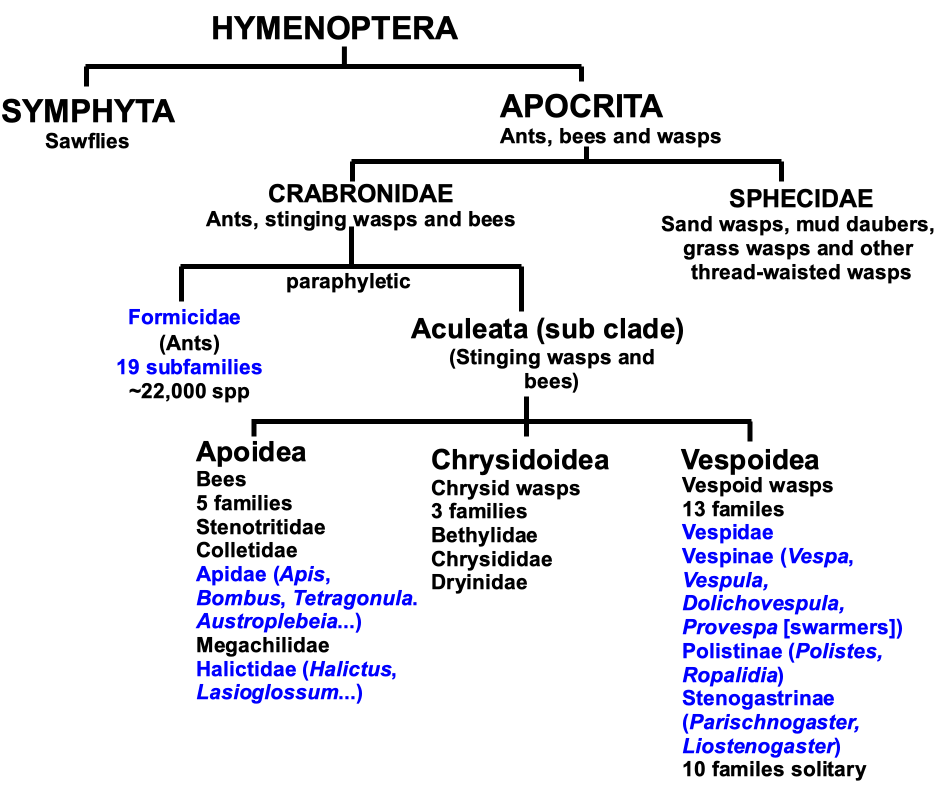
Figure 1 The social Hymenoptera tribes highlighted in blue.
Note: Of the subfamiles containing social or eusocial (non ant) species there are:
- three tribes of the Apidae: the Apini (Apis), the Bombini (Bombus) and the Meliponini (many genera e.g. Tetragonula, Austroplebeia);
- a limited number of social Halictidae species (sweat bees) mainly in the genera Halictus and Lasioglossum and some Xylocopinae (carpenter bees);
- four genera of the Vespinae: Vespa, Vespula, Dolichovespula and Provespa;
- four tribes of Polistinae (paper wasps): the Polistini, the Mischocyttarini, the Ropalidiini and the Epiponini; and
- seven genera of Stenogastrinae with species typically limited to a 2-10 total population size.
The ants, belonging to the social family Formicidae, contain many sub families and a plethora of species. As noted, social wasps all belong to the super family Vespoidae and are found in three families: the Vespidae (vespid wasps), the Polistinae (paper wasps) and the Stenogastrinae (hover wasps). All bees belong to the superfamily Apoidae, social species being restricted to just two families, the Apidae (some corbiculate and carpenter bees) and the Halictidae (a restricted number of sweat bees). Their origins date back many millions of years (Table 1).
| Social Taxa | Progenitors | Origin date (mya) | Number of queen mates | Number of social species |
| Halictid bees (Halictidae) sweat bees | 3 | 15-28 | Usually 1 1-3 in Halictus | 140 + 217 + 544 |
| Allodapine bees (Allodapinae) | 1 | 41-65 | 1? | 0 |
| Corbiculate bees (Apidae) | 1 | 78-95 Apini (56-61) Meliponini (12-21) Bombini (28-35) Euglossini (65) | 8-44 in Apis 1 (e.g.Tetragonula-Austroplebeia)1-3 in Bombus 1 (rarely social) | 1000 |
| Sphecid wasps (Sphecidae) | 1 | ~140 | 1 | 0 |
| Stenogastrine wasps (Stenogastrinae) hover wasps | 1 | ~80 | 1 (occasionally more e.g Parischnogaster spp, Liostenogaster vechti) | 7 genera |
| Polistine and vespine wasps (Vespidae) | 1 | ~80 | Usually 1 2 in Vespula spp. | 860 |
| Ants (Formicidae) | 1 | 115-135 | 1 | 12,000 |
Table 1 Wasp and bee origins and diversity metrics.
The social wasps
In terms of the number of species, the social wasps are less diverse than the ants but on a par with the bees. Wasp nest structures, the non-living colony component of the colony, are the handiwork of their denizens. Some wasp nests are constructed of flat or domed comb(s) built in the open (e.g. Polistes) and egg-shaped nests (e.g. Dolichovespula), others are subterranean or cavity dwelling. Some but by no means all species encase themselves in a weather proofing envelope, examples of which include the nests of the subterranean European wasp, the hanging paper bag wasps and the aerial Northern Hemisphere yellowjackets. Nesting materials range from mud (stenogastrine wasps) or lined earthen tunnels to plant fibres (vespine and paper wasps). Most social wasps employ their often hexagonal cells for the sole purpose of raising brood though some store small reserves of nectar and macerated insect prey: honey bees, stingless bees and bumblebees, on the other hand, employ often specialised cells for longer-term storage of cured nectar and pollen.
The vespid wasps: Family Vespidaeii (Superfamily Vespoidae)
The eusocial vespid wasps belong to three subfamilies: Vespinae (vespine wasps), Polistinae (paper wasps) and Stenogastrinae (hover wasps).
Common genera of the vespine wasps include the exotic [for the southern hemisphere] Vespula wasps (e.g. the European wasp Vespula germanica widely distributed in eastern and south western Australia and the common wasp Vespula vulgaris), Hornets (Vespa, notably Asian species) and the northern hemisphere Areal yellowjackets (Dolichovespula).
Vespula wasps: Vespula spp
This is a small genus of twenty three wasps of which the European and common wasp are widespread globally and are generally a problem for native insects as well as for honey bees.
The European wasp (Vespula germanica) was first detected in Tasmania in 1959 and is now widespread in south-eastern Australia, southern South Australia and smaller areas in South Western Australia. It is widely distributed in the temperate zones of Europe, the Americas and elsewhere and even in the tropics at elevated locations, e.g. The Cameron Highlands in Malaysia.
Spradberyiii reports that European wasp colonies are established from overwintered queens – we have found plenty in stored material in our bee shed: this method of annual establishment from founding queens is nearly universal amongst social wasps. Those founded annually build to populations varying in size from about 500 to 3000 individuals. The European wasp was first detected in New Zealand in 1922 and it seems likely that separate incursions to Australia came from there in imported cargo. Thomas (1960) reportsiv a New Zealand colony containing of 11,900 wasps. However Australian colonies that overwinter can reach a much greater size, the Australian Museum recording a colony with over 100,000 waspsv.
Vespula wasps nest underground in a horizontal multiple comb arrangement (Figure 2) further encased in a papery envelope located at the end of a short narrow passageway. The British Pest Control Association presents an excellent image of hexagonal comb with developing larvae (Figure 3) of the European wasp.

Figure 2 Vespula germanica layered combs encased in a mud and fibre envelopevi.
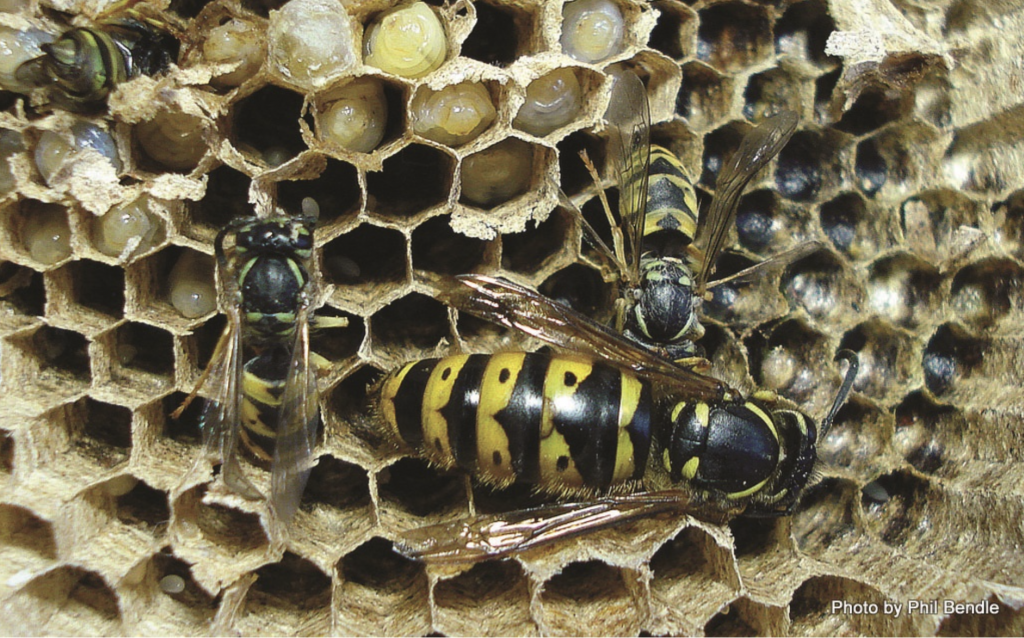
Figure 3 Vespula germanica comb structure with larvaevii.
Spradbery describes the nest structure and cell sizes, as well as detailed seasonal dynamics of brood in all stages of development for Vespula germanica (Table 2) and for the smaller Vespula vulgaris (Table 3)viii. Both species are common around Melbourne where Vespula vulgaris was originally confused with the more widely distributed Vespula germanicaix. Towards the end of the season, the European wasp colony constructs cells that are 21% larger than worker cells (twice the volume and 17% greater diameter at the comb face) to raise both queens and drones (Figure 4). These wasps also raise smaller queens and drones in worker cells, an atypical behaviour shared with the Aerial yellowjacket, Dolichovespula arenarea.
| Cell type | Width (mm) | Depth (mm) |
| Queen | 6.65±0.09 | 21.94±0.21 |
| Drone | 6.66±0.06 | 17.52±0.36 |
| Worker | 4.96±006 | 18.03±0.17 |
Table 2 Queen, drone and worker cell sizes for Vespula germanica.x
| Cell type | Width (mm) | Depth (mm) | ||
| Mean | Range | Mean | Range | |
| Worker | 4.51 | 4.0-6.1 | 13.72 | 11.4-17.3 |
| Queen | 6.27 | 6.0-6.5 | 14.18 | 12.8-15.3 |
Table 3 Queen and worker cell sizes for Vespula vulgarisxi.
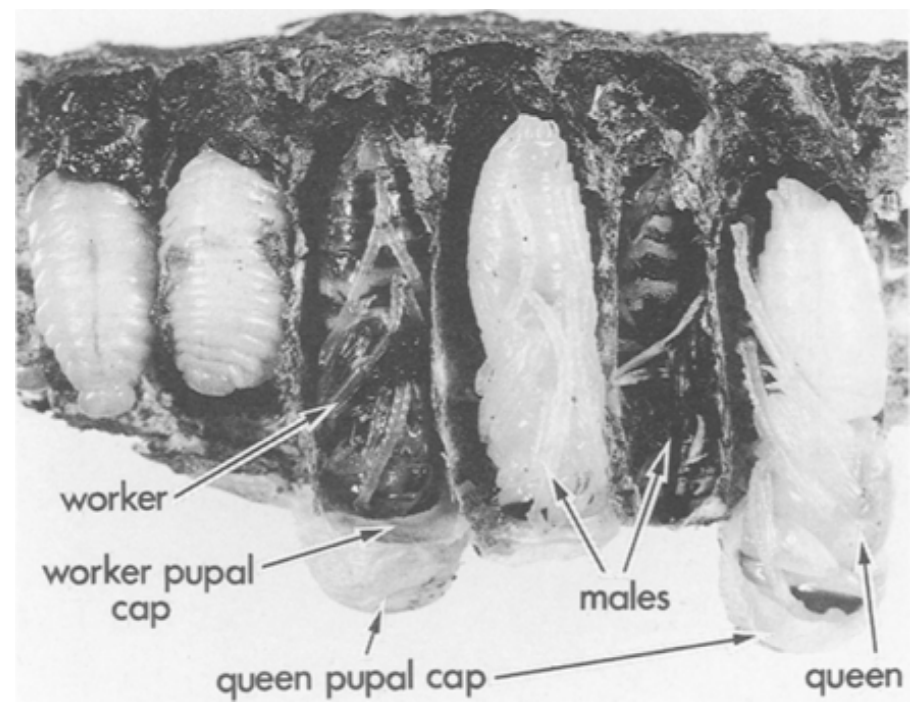
Figure 4 Transverse section of Vespula germanica brood comb (after Spradbery 1993).
Vespula wasps are both scavengers of dead bees and also take lives bees and noticeably dart in and take bees during hive inspections. They are a notable problem in queen breeder apiaries where slow moving queens on mating flights are easy prey.
Aerial yellowjackets: Dolichovespula spp
Dolichovespula is another genus of black or yellow-faced wasps found in much of the Northern Hemisphere. They are about twenty four species and are similar in most ways to Vespula but are typically much longer faced (Figure 5). Nests are egg-shaped (Figure 6) and are located in trees or attached to dwellings. The nests are encased in multiple-layered papery shellsxii containing horizontal combs with typical hexagonal cells hanging below the comb face.

Figure 5 Bald-faced hornet, Dolichovespula maculata widespread in temperate North America.xiii
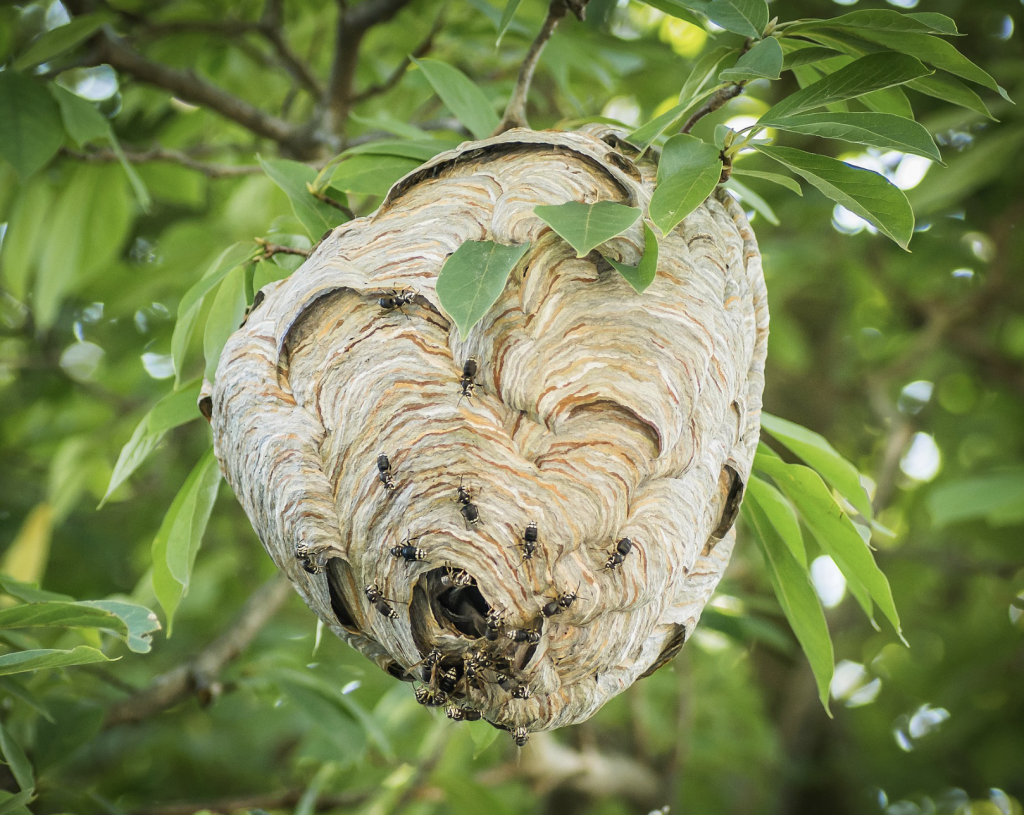
Figure 6 Bald-faced hornet, Dolichovespula maculata nest attached to tree branch.xiv
Aerial yellowjackets are comparable in size to Vespula, the Bald-faced hornet being 13 mm long and the queens rather larger at 20 mm.
Hornetsxv: Vespa orientalis, mandarinia
Hornets are large and aggressive wasps predating on a variety of insects, not least flies, cockroaches and bees. The giant Asian hornet Vespa mandarinia reaches up to 55 mm in length and is suspected of causing the Giant mountain honey bee, Apis laboriosa, another formidable stinging insect, to abscond. Most hornets are well known for destroying honey bee colonies, selectively decapitating guard bees, invading colonies and removing all bees and brood.
Moreover the Lord thy God will send the hornet among them, until they that are left, and hide themselves from thee, be destroyed.
Deuteronomy 7:20
There are twenty two Vespa species known from Europe, Africa and Europe, five of which have been nominated as of particular concern (Table 4).
| Hornet species | Common name | Nest | Population |
| Vespa velutina | Asian hornet | Suspended paper nest | about 430 (up to over 1000) |
| Vespa crabroxvi | European hornet | Paper nest in hollows | 200-400 (up to 1000) |
| Vespa orientalis | Oriental hornet | Paper nest underground or in cavities | about 2000 |
| Vespa affinis | Lesser banded hornet | Paper nest mainly in trees | ? |
| Vespa mandarinia | Asian giant hornet | Subterranean nesting | ? |
Table 4 Size and origin of common Vespa wasps.
The brood development times and size of nest for these species varies considerably (Table 5), the size of the insects being similarly variable within and between species (Table 6) and even seasonally.
| Hornet species | Common name | Egg | Larva | Pupa | Total | No. combs | No. cells | Cell diameter (mm) | Cell depth (mm) | Worker size* (mm) | ||
| Small | Large | Small | Large | |||||||||
| Vespa velutinaxvii | Asian hornet | 13 | 16 | 19 | 48 | 2-11 | 590-6200 | ns | ns | ns | ns | 20 [30, 24] |
| Vespa crabroxviii | European hornet | 5-18 | 9-19 | 13-15 | 27-51 | 3-33 | 595-6600; 1500-3000 | ns | ns | ns | ns | 25 [35, <25] |
| Vespa orientalisxix | Oriental hornet | 5-6 | 15-24 | 15-16 | 36-45 | 1-6; 3-6 | 600-4200; 600-900 | 7 | 9 | 16-18 | 22-24 | 25-35 |
| Vespa affinisxx | Lesser banded hornet | 6-7 | 15 | 15-20 | 36-41 | 5-9 | 1060-45,000 | ns | ns | ns | ns | 25 [30, 26} |
| Vespa mandariniaxxi | Asian giant hornet | – | – | – | 38 | 5 | 675-4700 | ns | ns | ns | 35-39 [<50; 35-39]] | |
Table 5 Seasonally variable brood development of common Vespa wasps;xxii also variable with nest development stage, number of nests examined and geographical location.
Note: In early nest development stage, smaller cells and wasps are produced.
[Queen, drone sizes]
| Hornet species | Common name | Length (mm)xxiii | Queen (mm) | Drone (mm) | Worker (mm) | Origin |
| Vespa velutinaxxiv | Asian hornet | 17-32 | 30 | 24 | 20 | Southern China |
| Vespa crabroxxv | European hornet | 18-23 | 35 | ? | 25 | Europe |
| Vespa orientalisxxvi | Oriental hornet | 18-23 25-35 | ? | ? | ? | SW Asia, NE Africa, Madagascar |
| Vespa affinisxxvii | Lesser banded hornet | 22-25 (queens 30) | 30 | 20-27 | 20-27 | Asia, tropical and subtropical |
| Vespa mandariniaxxviii | Asian giant hornet | 55 (wingspan 76) | 50 | 38 | 35-40 | Tropical East Asia, South Asia, Mainland Southeast Asia, and parts of the Russian Far East |
Table 6 Characteristic sizes of Vespa wasps.
Like honey bees, a few Vespa species have a wide climatic range. For example the Lesser Banded Hornet has both tropical tropical and temperate races. Michael Archer provides an excellent summary of the literature of Provespa and Vespa wasps including detailed notes on their natural distribution and global spread, their genetic variability, nesting behaviour, larval development and seasonal population dynamics.
The Polistine wasps (Polistinae: Vespidae): Polistes, Ropalidia
There are two genera of social polestine wasps comprising some forty three species in Australia, and some 800 in these and other genera worldwidexxix.
The Australian Paper Wasp Polistes humilis is widespreadxxx but has been largely replaced by Polistes chinensis in the Canberra region. As with most social wasps species, Polistes nests are constructed from chewed plant material mixed with saliva and propolis. Paper wasps nests are constructed as an inverted umbrella attached to an overhanging substrate by a short pedicel (stem). Queens and workers are of the same size. Roughly circular domed nests may reach a total count up to ~ 400 cells. Polistes chinensis colonies tend to be larger though the percentage of cells occupied by pre-emerging larvae varying between 54 and 64% in the peak brood raising month of Januaryxxxi. Colony size is dependent on local conditions, colonies sometimes employing old comb in nest reestablishment in spring. Both males and females overwinter as pupae though males emerge later in the season.
In warmer climes Polistes wasp colonies may overwinter with several queens. In one study of the native Polistes humilis, Cumberxxxii records nest sizes varying widely containing from 20-30 to over 1000 cells (nest size (290 x 110 mm2) where he found up 400 larvae or ~ 35% occupancy.
Here are measurements of a late season Chinese paper wasp nest (Polistes chinensis) I collected in Canberra recently (Table 7). The colony was in typical autumn decline and broodless (Figure 7) and contained several, likely male, wasps with longer wings and wider gasters (abdomens).
| Colony feature | Size | Weight | Number of combs |
| Nest | 100x80x20 mm3 (domed to 25 mm total) | 5 g | single comb |
| Pedicel | 5 mm | ||
| Drone* | 15 mm | 3 | |
| Worker | 13-14 mm | 130 mg | 16 (possibly all queens) |
| Cells | 5.5 mm dia. | 376 (~20+ old cells) |
Table 7 Paper wasp (Polistes chinensis) late season broodless nest metrics.
Note: abdomen wider on three insects, wings extending beyond last tergite.
*Only males are produced from mid-to-late summer: queens and workers are morphologically identical.

Figure 7 Chinese paper wasp nest 11 May 2023:
(a) in garden at Echo Place Lyons ACT; and
(b) measuring up in kitchen.
Ropalidia romandi
The common Yellow brown paper bag wasp of tropical eastern and northern Australia is very different to the paper wasps most of us are familiar with. And for the unwary, the paper bag is not something you will find your lunch packed in. As its name suggests the colony forms a protective envelope around the comb, extending that envelope to encompass any new comb built. And, like honey bees and stingless bees, it forms a perennial nest and is a swarm-founding as well being a solitary queen founding species. So a mature nest can be either small or quite large, though the wasp itself (Figure 8) at a length of ~12 mm is, in wasp terms, relatively small.
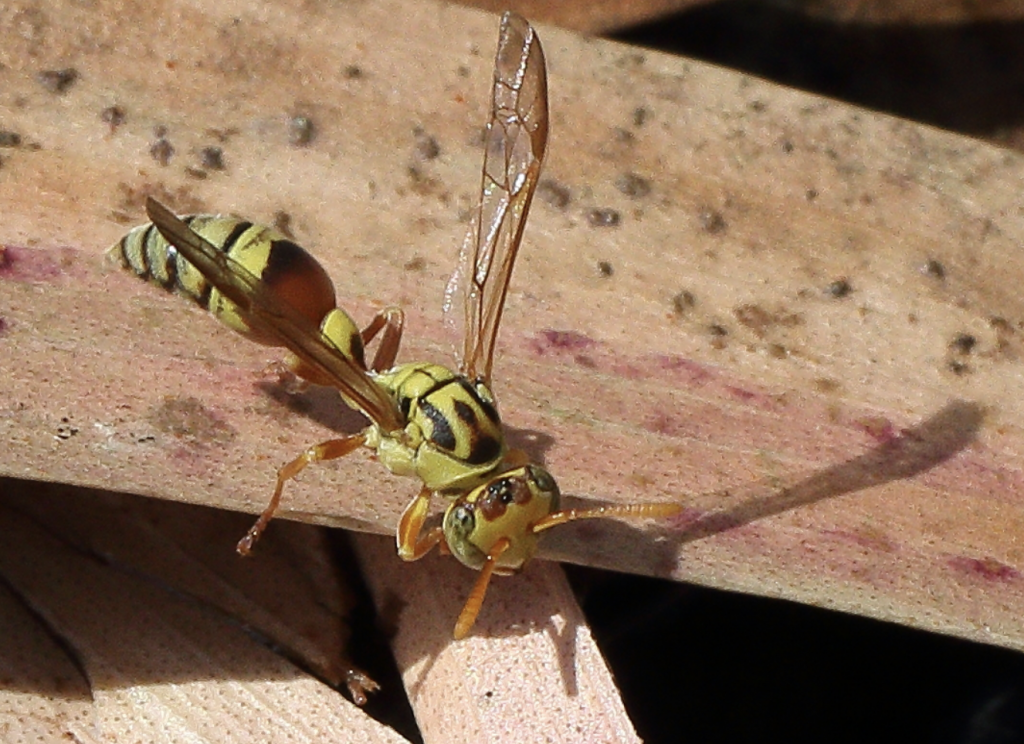
Figure 8 Yellow brown paper wasp Ropalidia romandixxxiii
The Yellow brown paper bag wasps also remarkable in that this species not only swarms but may contain more than a single mated (egg-laying) queen. Like some races of African Apis mellifera bees can also form absconding swarms where the whole colony departs in response to disturbance. And, like honey bees, the departure is orchestrated by the workers, not by the queen.
Combs are horizontal and single-sided and can reach 1 m in length. One exceptionally large nest, comprising ten combs connected by supporting pedicels, contained ~ 30,000 cells and had a comb surface area of 1950 cm2. To get a handle on this extraordinary real estate that’s equivalent to about the number of cells found in an equivalent eight full depth Langstroth frames.
Australia has not just one but three species of Ropalidia. There are two tropical species, Ropalidia romandi, the Yellow brown paper waspxxxiv and Ropalidia revolutionalis, the Stick nest brown paper wasp, both found in northern and north eastern Australia. A further temperate zone species, Ropalidia plebeiana, the White-faced brown paper wasp, forms small colonies with several males and a number of queens. It has been found as far south as south eastern New South Wales.
As well as being a swarm-founding wasp the Yellow brown paper wasp (Ropalidia romandi) is unusual in that maintains a perennial nest (Figure 9). Yamane and Itôxxxiv provide details of nest architecture of Ropalidia romandi: cells have a diameter of 2.3 ± 0.2 mm.
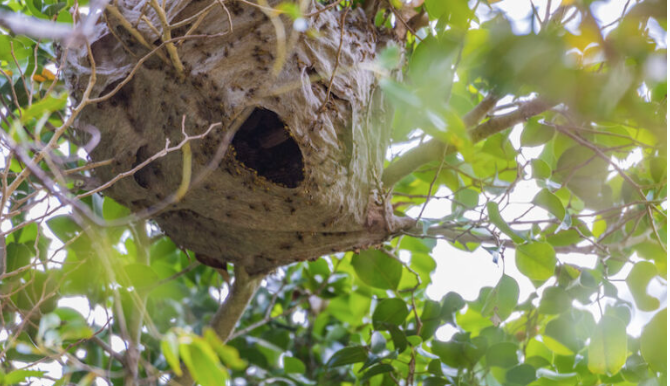
Figure 9 Ropalidia romandi nestxxxv.
The Stenogastrine wasps: (Stenogastrinae: Vespidae) Hover wasps
Colonies of hover wasps are usually limited to no more than ten individuals, are flexible in structure and lack the true workers of other social wasps: they are facultatively eusocialxxxvi. The nests are tiny (Figure 10) and colonies have a long gestation, that is they build up very slowly. The absence of a pedicel to hang the nest from and poor nest constructing material are features that seem likely to have prevented further evolution of hover wasps. There are seven known genera of hover wasp not all well characterised: Metischnogaster, Cochlischnogaster, Stenogaster, Anischnogaster, Liostenogaster, Parischnogaster, Eustenogaster xxxvii. A few nests are depicted in the following images (Figure 10).

Figure 10 Stenogastrine (hover wasp) nests attached directly to substrate.:
(a) Liostenogaster vechti colonies;
(b) Eustenogaster micans nest;
(c) Eustenogaster calyptodoma cells; and
(d) Eustenogaster fraterna nest.
In future Bee Buzz Box instalments we will move on to exploring the nesting biology of a few other bee families but, as a parting thought, we could well do without many of these wasps, especially the hornets.
Readings
iWikipedia (accessed 23 May 2023). Evolution of eusociality. https://en.wikipedia.org/wiki/Evolution_of_eusociality
iiVariety of Life (accessed 04 May 2023). Vespidae. https://varietyoflife.com.au/vespidae/
iiiSpradbery J.P. and Maywald G.F. (1992). The distribution of the European or German wasp, Vespula germanica (F.)(Hymenoptera: Vespidae), in Australia: past, present and future. Australian Journal of Zoology 40(5):495-510. https://www.publish.csiro.au/ZO/ZO9920495
ivThomas, C.R. (1960). The European wasp (Vespula germanica Fab.) in New Zealand., New Zealand Department of Industrial Research Information Seies No. 27, 74 pp. .https://www.cabdirect.org/cabdirect/abstract/19620501087
vAustralian Museum (December 2020). European wasp. https://australian.museum/learn/animals/insects/european-wasp/
viBendle, P. CitScihub. (accessed 21 May 2023). Wasps nests (photos and text). https://www.citscihub.nz/Phil_Bendle_Collection:Wasp_nests_(Photos_and_text)
viiBendle, P. (July 2019). British Pest Control Association: Pestwatch: Life cycle of a wasp. https://bpca.org.uk/a-z-of-pest-advice/wasp-control-how-to-get-rid-of-wasps-bpca-a-z-of-pests/188976
viiiGreene, A., Akre, R.D. and Landolt, P. (1976). The aerial yellowjacket, Dolichovespula arenaria (Fab.): Nesting biology, reproductive production, and behavior (Hymenoptera: Vespidae). Melanderia 26:1-34.
ixKasper, M.L. Reeson, A.F. and Austin, A.D. (2008). Colony characteristics of Vespula germanica (F.) (Hymenoptera, Vespidae) in a Mediterranean climate (southern Australia). Australian Journal of Entomology 47(4):265–274. doi:10.1111/j.1440-6055.2008.00658.x
xSpradbery, J.P. (1993). Queen brood reared in worker cells by the social wasp, Vespula germanica (F.) (Hymenoptera: Vespidae). Insectes Sociaux 40(2):181–190. doi:10.1007/bf01240706
xiSpradbery J.P. (1971). Seasonal changes in the population structure of wasp colonies (Hymenoptera: Vespidae). Journal of Animal Ecology 40:501–523. https://www.jstor.org/stable/3259 doi.org/10.2307/3259
xiiBalduf, W.V. (1954). Observations on the white-faced wasp Dolichovespula maculata (Linn)(Vespidae, Hymenoptera). Annals of the Entomological Society of America 47(3):445-458. https://academic.oup.com/aesa/article-abstract/47/3/445/56906?login=false
xiiiPenn State University. (14 April 2023). Baldfaced hornet. https://extension.psu.edu/baldfaced-hornet
xivWikimedia Commons (accessed 21 May 2023). Dolichovespula maculata (bald-faced hornet) nest. https://commons.wikimedia.org/wiki/File:Dolichovespula_maculata_(bald-faced_hornet)_nest.jpg
xvNew South Wales Department of Primary Industries (accessed 15 May 2023). Hornets. https://www.dpi.nsw.gov.au/biosecurity/plant/insect-pests-and-plant-diseases/hornet
xviUS Department of Agriculture (June 1981). Agriculture handbook Number 552. The yellowjackets of America North of Mexico, pp.32-35. https://naldc.nal.usda.gov/download/CAT82762500/PDF
xviiArcher, M.E. (1994). Taxonomy, distribution and nesting biology of the Vespa bicolor group (Hym., Vespinae). Entomologist’s Monthly Magazine 149-158. https://www.academia.edu/4236740/Taxonomy_distribution_and_nesting_biology_of_the_Vespa_bicolor_group_Hym_Vespinae_1994_
xviiiUS Department of Agricuture (June 1981). Agriculture handbook Number 552. The yellowjackets of America North of Mexico, pp.32-35. https://naldc.nal.usda.gov/download/CAT82762500/PDF
xixArcher, M.E. (1998). Taxonomy, distribution and nesting biology of Vespa orientalis L. (Hym., Vespidae). Entomologist’s Monthly Magazine 45-51. https://www.academia.edu/4236674/Taxonomy_distribution_and_nesting_biology_of_Vespa_orientalis_L_Hym_Vespidae_1998_
xxArcher, M.E. (1997). Taxonomy, distribution and nesting biology of Vespa affinis (L.) and Vespa mocsaryana du Buysson (Hym., Vespinae). Entomologist’s Monthly Magazine 27-38. https://www.academia.edu/4236774/Taxonomy_distribution_and_nesting_biology_of_Vespa_affinis_L_and_Vespa_mocsaryana_du_Buysson_Hym_Vesoinae_1997_
xxiArcher, M.E. (1995). Taxonomy, distribution and nesting biology of the Vespa mandarinia group (Hym., Vespinae). Entomologist’s Monthly Magazine 47-53. https://www.academia.edu/4236755/Taxonomy_distribution_and_nesting_biology_of_the_Vespa_mandarinia_group_Hym_Vespinae_1995_
Gill, C., Jack, C. and Lucky, A. (May 2020). Asian giant hornet: Vespa mandarinia Smith (1852) (Insecta: Hymenoptera: Vespidae). https://entnemdept.ufl.edu/creatures/MISC/BEES/Vespa_mandarinia.html
xxiiArcher, M.E. (1998). Taxonomy, distribution and nesting biology of species of the genera Provespa Ashmead and Vespa Linnaeus (Hymenoptera, Vespidae). Entomologist’s Monthly Magazine 69-101. https://scholar.google.com.au/scholar?hl=en&as_sdt=0%2C5&q=vespa+orientalis+biology&oq=vespa+orientalis
xxiiiNSW Department of Primary Industries (December 1995). Hornets. https://www.dpi.nsw.gov.au/biosecurity/plant/insect-pests-and-plant-diseases/hornet
xxivWikipedia (accessed 15 May 2023). Asian hornet. https://en.wikipedia.org/wiki/Asian_hornet
Lee, J.X.Q. (10 February 2018). Vespa velutina. http://www.vespa-bicolor.net/main/vespid/vespa-velutina.htm
xxvPenn State Extension (16 September 2021). European hornet. https://extension.psu.edu/european-hornet
xxviWikipedia (accessed 14 May 2023). Oriental hornet. https://en.wikipedia.org/wiki/Oriental_hornet
xxviiLin, L.Y. modified by Jonathan Ho Kit Ian (17 Sep 2020). Vespa affinis – Lesser banded hornet https://wiki.nus.edu.sg/display/TAX/Vespa+affinis+-+Lesser+Banded+Hornet
xxviiiWikipedia (accessed 14 May 2023). Asian giant hornet. https://en.wikipedia.org/wiki/Asian_giant_hornet
xxixAustralian Faunal Directory (accessed 18 May 2023). Subfamily Polistinae. https://biodiversity.org.au/afd/taxa/Polistinae
xxxiNaturalistAU (Retrieved 2 May 2023). Australian paper wasp, Polistes humilis. Sourced from Wikipedia (19 August 2019(. https://inaturalist.ala.org.au/taxa/181077-Polistes-humilis#cite_ref-nesting_10-0
xxxiClapperton, B.K. and Lo, P. (2000). Nesting biology of Asian paper wasps Polistes chinensis antennalis Peréz, and Australian paper wasps P. humilis (Fab.) (Hymenoptera: Vespidae) in northern New Zealand. New Zealand Journal of Zoology 27(3):189–195. doi:10.1080/03014223.2000.9518225
xxxiiCumber, R.A. (1951). Some observations on the biology of the Australian wasp Polistes humilis Fabr. (Hymenoptera: Vespidae) in North Auckland (New Zealand), with special reference to the nature of the worker caste. Proceedings of the Royal Entomological Society London (A) 26(1-3):11–16. doi:10.1111/j.1365-3032.1951.tb00104.x
xxxiiiWikimedia Commons (accessed 12 May 2023). Ropalidia romandi. https://commons.m.wikimedia.org/wiki/File:Ropalidia_romandi_7283.jpg#mw-jump-to-license..
xxxivYamane, S. and Itô, Y. (1994). Nest architecture of the Australian paper wasp Ropalidia romandi Cabeti, with a note on its developmental process (Hymenoptera: Vespidae). Psyche: A Journal of Entomology 101(3-4):145–158. doi:10.1155/1994/92839
xxxvProfessional pest manager (1 December 2022). Ropalidia – An Australian paper wasp with a difference. https://professionalpestmanager.com/pest-control-wasps/ropalidia-an-australian-paper-wasp-with-a-difference/
xxxviHines, H.M., Hunt, J.H., O’Connor, T.K., Gillespie, J.J. and Cameron, S.A. (2007). Multigene phylogeny reveals eusociality evolved twice in vespid wasps. Proceedings of the National Academy of Sciences of the USA 104(9):3295–3299. https://www.life.illinois.edu/scameron/publications/pdfs/hines2007pnas.pdf
xxxviiWikipedia (accessed 18 May 2023). Stenogastrinae https://en.wikipedia.org/wiki/Stenogastrinae
